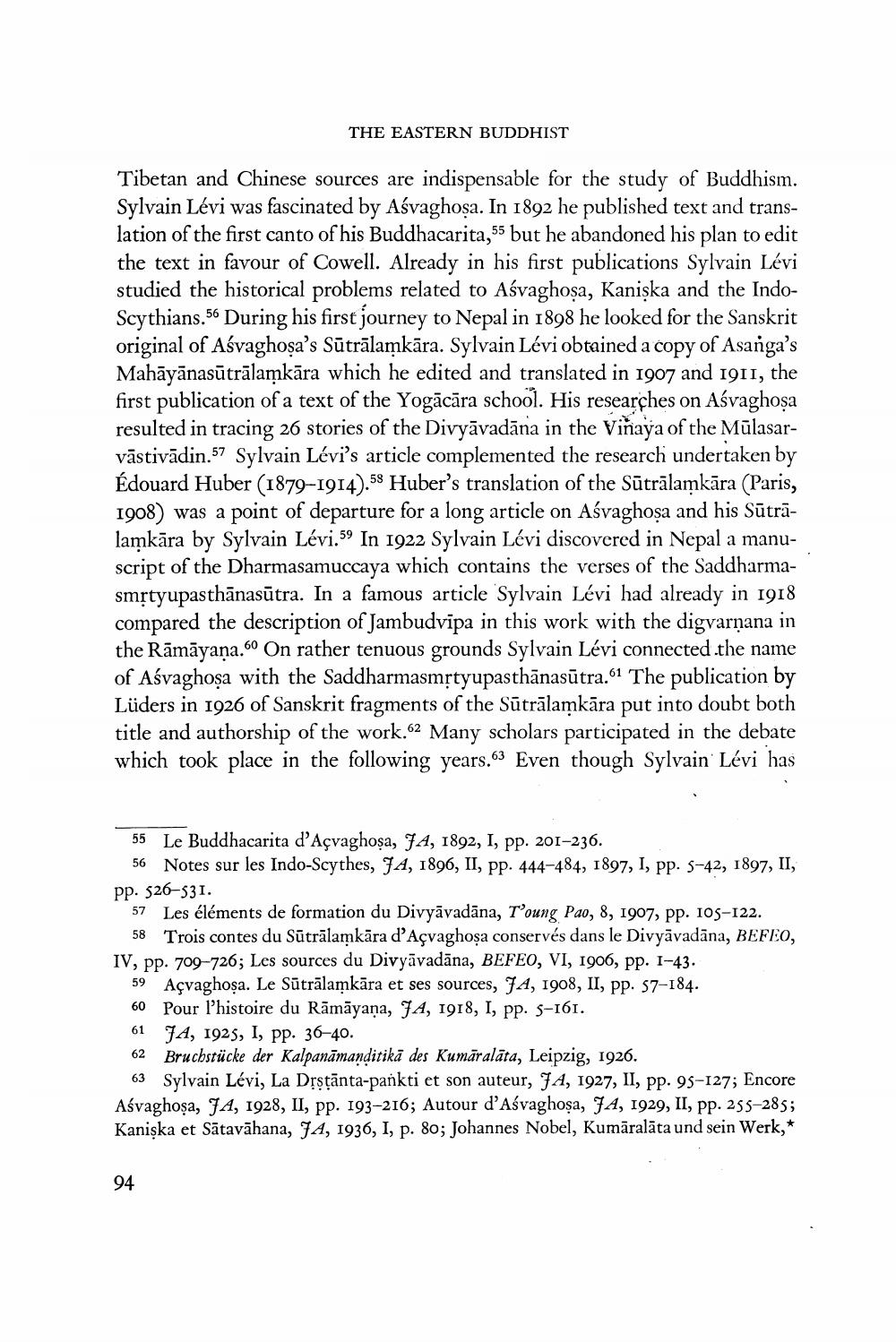________________
THE EASTERN BUDDHIST
Tibetan and Chinese sources are indispensable for the study of Buddhism. Sylvain Lévi was fascinated by Aśvaghosa. In 1892 he published text and lation of the first canto of his Buddhacarita,55 but he abandoned his plan to edit the text in favour of Cowell. Already in his first publications Sylvain Lévi studied the historical problems related to Aśvaghoșa, Kaniska and the IndoScythians.56 During his first journey to Nepal in 1898 he looked for the Sanskrit original of Asvaghosa's Sūtrālamkāra. Sylvain Lévi obtained a copy of Asanga's Mahāyānasūtrālamkāra which he edited and translated in 1907 and 1911, the first publication of a text of the Yogācāra school. His researches on Aśvaghoșa resulted in tracing 26 stories of the Divyāvadāna in the Viňaya of the Mūlasarvāstivādin.57 Sylvain Lévi's article complemented the research undertaken by Édouard Huber (1879–1914).58 Huber's translation of the Sūtrālamkāra (Paris, 1908) was a point of departure for a long article on Aśvaghosa and his Sūtrālamkāra by Sylvain Lévi.59 In 1922 Sylvain Lévi discovered in Nepal a manuscript of the Dharmasamuccaya which contains the verses of the Saddhari smrtyupasthānasūtra. In a famous article Sylvain Lévi had already in is compared the description of Jambudvipa in this work with the digvarnana in the Rāmāyana. On rather tenuous grounds Sylvain Lévi connected the name of Asvaghosa with the Saddharmasmrtyupasthānasūtra.61 The publication by Lüders in 1926 of Sanskrit fragments of the Sūtrālamkāra put into doubt both title and authorship of the work.62 Many scholars participated in the debate which took place in the following years.63 Even though Sylvain Lévi has
55 Le Buddhacarita d'Açvaghosa, JA, 1892, I, pp. 201-236.
56 Notes sur les Indo-Scythes, JA, 1896, II, pp. 444-484, 1897, I, pp. 5-42, 1897, II, PP: 526-531.
57 Les éléments de formation du Divyāvadāna, Toung Pao, 8, 1907, pp. 105-122.
58 Trois contes du Sūtrālamkāra d'Acvaghosa conservés dans le Divyāvadāna, BEFEO, IV, pp. 709–726; Les sources du Divyāvadāna, BEFEO, VI, 1906, pp. 1-43.
59 Açvaghosa. Le Sūtrālamkāra et ses sources, JA, 1908, II, pp. 57-184. 60 Pour l'histoire du Rāmāyaṇa, JA, 1918, I, pp. 5-161. 61 JA, 1925, I, pp. 36-40. 62 Bruchstücke der Kalpanāmanditikā des Kumāralāta, Leipzig, 1926.
63 Sylvain Lévi, La Drstānta-pankti et son auteur, JA, 1927, II, pp. 95-127; Encore Ašvaghoșa, JA, 1928, II, pp. 193-216; Autour d'Asvaghosa, JA, 1929, II, pp. 255-285; Kaniska et Sātavāhana, JA, 1936, 1, p. 80; Johannes Nobel, Kumāralāta und sein Werk,*
94




